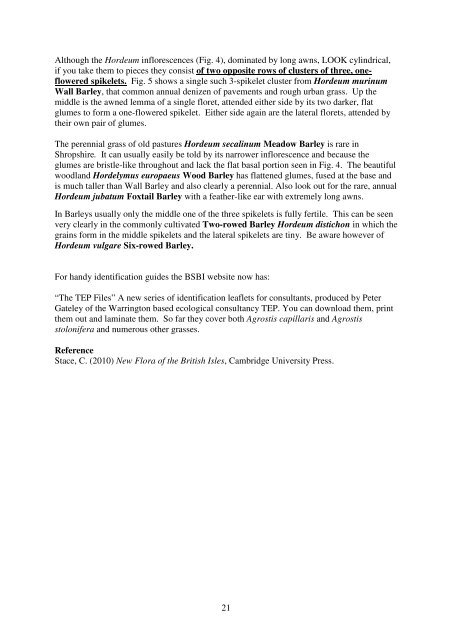Shropshire Botanical Society Newsletter - Botanical Society of the ...
Shropshire Botanical Society Newsletter - Botanical Society of the ...
Shropshire Botanical Society Newsletter - Botanical Society of the ...
You also want an ePaper? Increase the reach of your titles
YUMPU automatically turns print PDFs into web optimized ePapers that Google loves.
Although <strong>the</strong> Hordeum inflorescences (Fig. 4), dominated by long awns, LOOK cylindrical,if you take <strong>the</strong>m to pieces <strong>the</strong>y consist <strong>of</strong> two opposite rows <strong>of</strong> clusters <strong>of</strong> three, onefloweredspikelets. Fig. 5 shows a single such 3-spikelet cluster from Hordeum murinumWall Barley, that common annual denizen <strong>of</strong> pavements and rough urban grass. Up <strong>the</strong>middle is <strong>the</strong> awned lemma <strong>of</strong> a single floret, attended ei<strong>the</strong>r side by its two darker, flatglumes to form a one-flowered spikelet. Ei<strong>the</strong>r side again are <strong>the</strong> lateral florets, attended by<strong>the</strong>ir own pair <strong>of</strong> glumes.The perennial grass <strong>of</strong> old pastures Hordeum secalinum Meadow Barley is rare in<strong>Shropshire</strong>. It can usually easily be told by its narrower inflorescence and because <strong>the</strong>glumes are bristle-like throughout and lack <strong>the</strong> flat basal portion seen in Fig. 4. The beautifulwoodland Hordelymus europaeus Wood Barley has flattened glumes, fused at <strong>the</strong> base andis much taller than Wall Barley and also clearly a perennial. Also look out for <strong>the</strong> rare, annualHordeum jubatum Foxtail Barley with a fea<strong>the</strong>r-like ear with extremely long awns.In Barleys usually only <strong>the</strong> middle one <strong>of</strong> <strong>the</strong> three spikelets is fully fertile. This can be seenvery clearly in <strong>the</strong> commonly cultivated Two-rowed Barley Hordeum distichon in which <strong>the</strong>grains form in <strong>the</strong> middle spikelets and <strong>the</strong> lateral spikelets are tiny. Be aware however <strong>of</strong>Hordeum vulgare Six-rowed Barley.For handy identification guides <strong>the</strong> BSBI website now has:“The TEP Files” A new series <strong>of</strong> identification leaflets for consultants, produced by PeterGateley <strong>of</strong> <strong>the</strong> Warrington based ecological consultancy TEP. You can download <strong>the</strong>m, print<strong>the</strong>m out and laminate <strong>the</strong>m. So far <strong>the</strong>y cover both Agrostis capillaris and Agrostisstolonifera and numerous o<strong>the</strong>r grasses.ReferenceStace, C. (2010) New Flora <strong>of</strong> <strong>the</strong> British Isles, Cambridge University Press.21
















